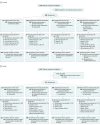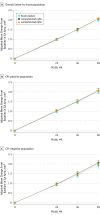Efficacy and Safety of Lampalizumab for Geographic Atrophy Due to Age-Related Macular Degeneration: Chroma and Spectri Phase 3 Randomized Clinical Trials
- PMID: 29801123
- PMCID: PMC6145777
- DOI: 10.1001/jamaophthalmol.2018.1544
Efficacy and Safety of Lampalizumab for Geographic Atrophy Due to Age-Related Macular Degeneration: Chroma and Spectri Phase 3 Randomized Clinical Trials
Abstract
Importance: Geographic atrophy (GA) secondary to age-related macular degeneration is a leading cause of visual disability in older individuals. A phase 2 trial suggested that lampalizumab, a selective complement factor D inhibitor, reduced the rate of GA enlargement, warranting phase 3 trials.
Objective: To assess the safety and efficacy of lampalizumab vs sham procedure on enlargement of GA.
Design, setting, and participants: Two identically designed phase 3 double-masked, randomized, sham-controlled clinical trials, Chroma and Spectri, enrolled participants from August 28, 2014, to October 6, 2016, at 275 sites in 23 countries. Participants were aged 50 years or older, with bilateral GA and no prior or active choroidal neovascularization in either eye and GA lesions in the study eye measuring 2.54 to 17.78 mm2 with diffuse or banded fundus autofluorescence patterns.
Interventions: Participants were randomized 2:1:2:1 to receive 10 mg of intravitreous lampalizumab every 4 weeks, sham procedure every 4 weeks, 10 mg of lampalizumab every 6 weeks, or sham procedure every 6 weeks, through 96 weeks.
Main outcomes and measures: Safety and efficacy assessed as mean change from baseline in GA lesion area at week 48 from centrally read fundus autofluorescence images of the lampalizumab arms vs pooled sham arms, in the intent-to-treat population and by complement factor I-profile genetic biomarker.
Results: A total of 906 participants (553 women and 353 men; mean [SD] age, 78.1 [8.1] years) were enrolled in Chroma and 975 participants (578 women and 397 men; mean [SD] age, 77.9 [8.1] years) were enrolled in Spectri; 1733 of the 1881 participants (92.1%) completed the studies through 48 weeks. The adjusted mean increases in GA lesion area from baseline at week 48 were 1.93 to 2.09 mm2 across all groups in both studies. Differences in adjusted mean change in GA lesion area (lampalizumab minus sham) were -0.02 mm2 (95% CI, -0.21 to 0.16 mm2; P = .80) for lampalizumab every 4 weeks in Chroma, 0.16 mm2 (95% CI, 0.00-0.31 mm2; P = .048) for lampalizumab every 4 weeks in Spectri, 0.05 mm2 (95% CI, -0.13 to 0.24 mm2; P = .59) for lampalizumab every 6 weeks in Chroma, and 0.09 mm2 (95% CI, -0.07 to 0.24 mm2; P = .27) for lampalizumab every 6 weeks in Spectri. No benefit of lampalizumab was observed across prespecified subgroups, including by complement factor I-profile biomarker. Endophthalmitis occurred after 5 of 12 447 injections (0.04%) or in 5 of 1252 treated participants (0.4%) through week 48.
Conclusions and relevance: In Chroma and Spectri, the largest studies of GA conducted to date, lampalizumab did not reduce GA enlargement vs sham during 48 weeks of treatment. Results highlight the substantial and consistent enlargement of GA, at a mean of approximately 2 mm2 per year.
Trial registration: ClinicalTrials.gov Identifier: NCT02247479 and NCT02247531.
Conflict of interest statement
Figures


References
-
- Flaxman SR, Bourne RRA, Resnikoff S, et al. ; Vision Loss Expert Group of the Global Burden of Disease Study . Global causes of blindness and distance vision impairment 1990-2020: a systematic review and meta-analysis. Lancet Glob Health. 2017;5(12):e1221-e1234. - PubMed
-
- Rudnicka AR, Kapetanakis VV, Jarrar Z, et al. . Incidence of late-stage age-related macular degeneration in American whites: systematic review and meta-analysis. Am J Ophthalmol. 2015;160(1):85-93.e3. - PubMed
-
- Wong WL, Su X, Li X, et al. . Global prevalence of age-related macular degeneration and disease burden projection for 2020 and 2040: a systematic review and meta-analysis. Lancet Glob Health. 2014;2(2):e106-e116. - PubMed
-
- Brown DM, Kaiser PK, Michels M, et al. ; ANCHOR Study Group . Ranibizumab versus verteporfin for neovascular age-related macular degeneration. N Engl J Med. 2006;355(14):1432-1444. - PubMed
-
- Heier JS, Brown DM, Chong V, et al. ; VIEW 1 and VIEW 2 Study Groups . Intravitreal aflibercept (VEGF trap-eye) in wet age-related macular degeneration. Ophthalmology. 2012;119(12):2537-2548. - PubMed
Publication types
MeSH terms
Substances
Associated data
LinkOut - more resources
Full Text Sources
Other Literature Sources
Medical
Miscellaneous

